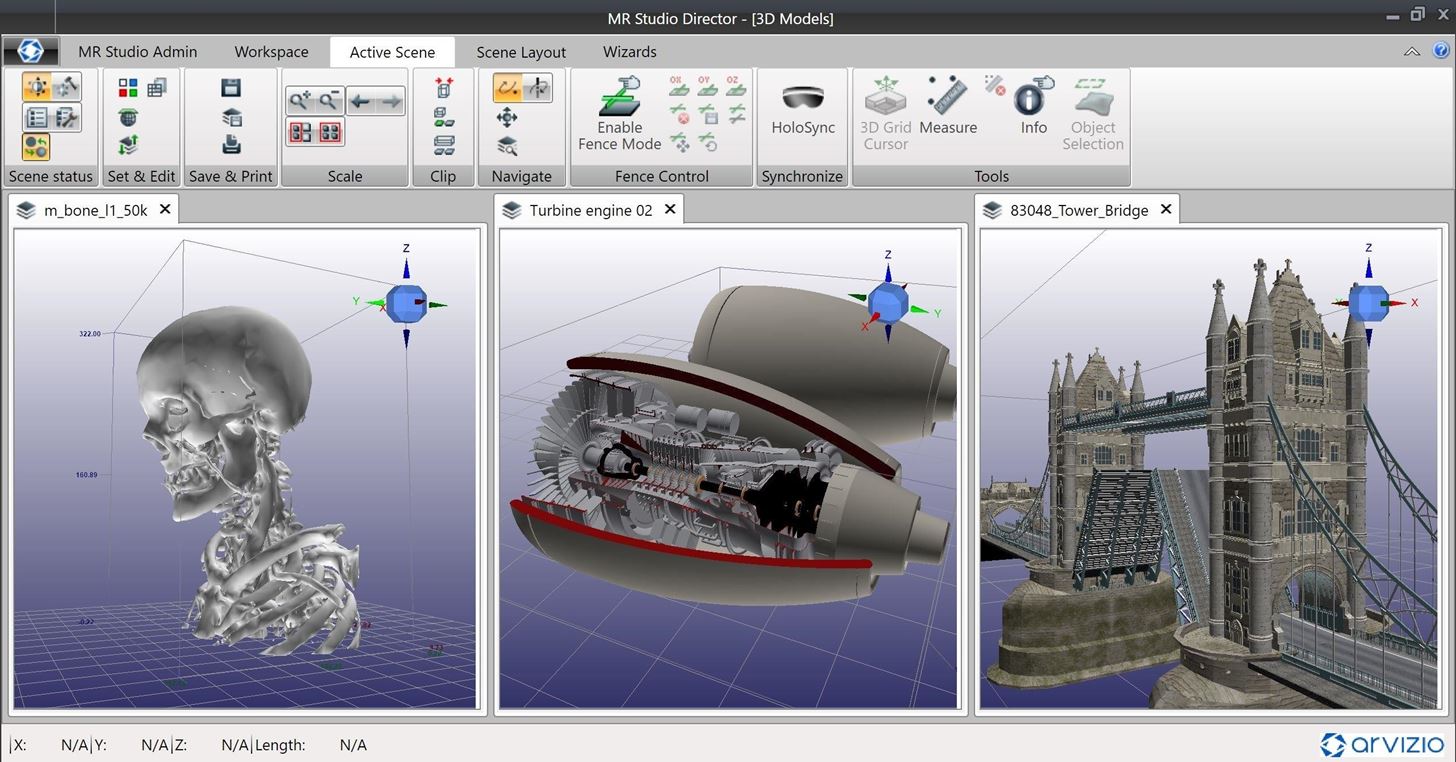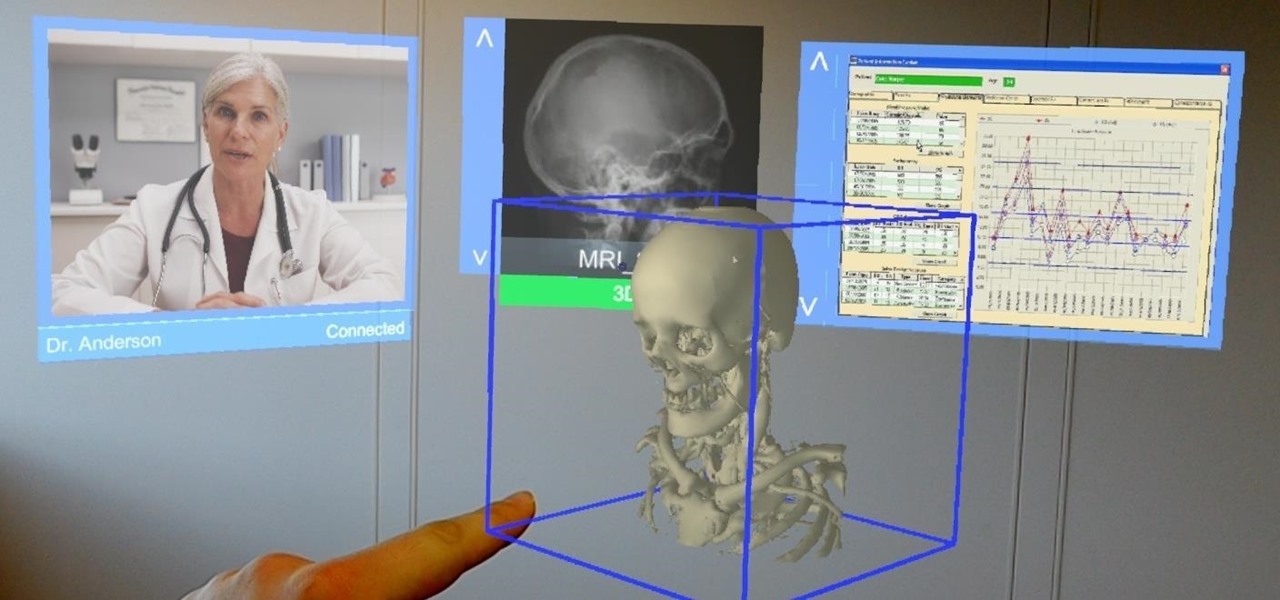Augmented and mixed reality developer Arvizio is working on a suite of software solutions for enterprises that will extend HoloLens capabilities as a full-fledged collaboration and conferencing tool. The company will demonstrate its Mixed Reality Studio suite to attendees at the Augmented World Expo, which begins later this month in Santa Clara, California.
What Arvizio aims to provide enterprise customers through Mixed Reality Studio is advanced 3D visualization and real-time collaboration with the ability to integrate data with existing IT systems and applications, such as databases for medical records or real-time analytics from IoT devices.
"The mixed reality experience is very much the future of communications, but to make that happen requires new types of systems and platforms that really combines these three key elements," said Jonathan Reeves, CEO and co-founder of Arvizio, in an interview with Next Reality. "The advanced 3D visualization because the real world is complex, you need to be able to visualize real world types of scale. You need real-time communications so you can extend the experience remotely, and you need to be able to integrate this with your existing IT systems."

Mixed Reality Studio consists of three applications that work in concert. Mixed Reality Studio Director, a PC application that can be deployed to workstations or run from a server, acts as the hub, orchestrating the full visualization and collaboration experience. Through this application, administrators can import files, such as CAD or medical imaging, annotate the content, and publish the visualizations to users.
Mixed Reality Studio Immerse runs through HoloLens to present content from MR Studio Director. Immerse is built on the Unity framework supplemented with native plugins to improve performance for features such as 3D visualization, real-time communications, and video chat and networking.
"The net result of this is you would run the Immerse application in the HoloLens, connect that to Studio Director, and the combination of those two gives you the seamless experience, where you can bring things up on the workstation, you can publish it to the HoloLens, and then you can see the models in the HoloLens," said Reeves.

In addition, the combination of the Immerse and Director applications creates a sharing experience for the users. To accomplish this, Arvizio built their own sharing server from the ground up, optimized for multiple users.
"If you're in a conference room and you wanted to put a large 3D model on the conference room table, then multiple users can see that model locked in the same position, and literally, you can have a collaborative experience. You can point to things, you can talk about it, and everybody sees the same thing as if the model were really there on the table," said Reeves.
The third component, Mixed Reality Studio Remote, runs on tablets, smartphones, or smartglasses and allows remote participants not in the same location to view the same visualization that HoloLens users see through the Immerse application. Remote users can select any of the available HoloLens perspectives. Through tools in the application that mimic the HoloLens hand gestures, users can interact with the model.

"What they will see is the view being sent from one or more of the HoloLens, such that they can now get the whole experience. They can see the 3D view, and they can then participate in the discussion," said Reeves.
Remote users can connect to visualization sessions on Android and Windows devices either through a dedicated app or via a secure browser link. iOS support is contingent upon expected real-time communication enhancements for Safari.
What we felt was that a lot of people are coming at these types of scenarios really building an app for the HoloLens or other devices. We felt that a slightly different approach was required; Instead of just building an app that is going to run on the device, that actually there is a suite of piece parts that needs to be pulled together.
With the Mixed Reality Studio suite, Arvizio believes they have solved a number of problems that would otherwise prevent enterprises from adopting mixed reality as a business tool.
"What we have found from our experience is that there are a number of limitations with the HoloLens today that can restrict the types of applications that it can serve. With some creative technologies and approaches, we believe we can overcome some of those key limitations," said Reeves.
One of these limitations is processing power. Detailed 3D models require not only a high frame rate for a smooth experience but also processing billions of data points for models with more than 200,000 polygons. So, the Director application crunches the models and serves a portion of the model to the Immerse applications as needed. This allows users to present much larger models.
Security and integration are also a primary concern for corporate IT departments. Arvizio addresses security by encrypting data that is sent from Director to Immerse and Remote users. In terms of integration into existing systems and workflows, Arvizio developed their own Advanced Spatial Processing Engine (ASPEN) to unify more than 20 spatial formats.
"The Mixed Reality Studio is the first example I've seen in which server-hosted capabilities are designed from the ground up to complement the display device while integrating with an IT architecture. In addition, many HoloLens customers are keen to use AR as a part of collaborative activities. Arvizio's MR Studio features will permit richer shared experiences and help customers explore the new use-cases for AR," said Christine Perey, principal at PEREY Research & Consulting, in an email statement provided to Next Reality.
Arvizio is currently conducting trials with a number of customers advising and helping figure out how to use the software in various enterprise scenarios. The company expects to begin a formal closed beta of MR Studio this summer with a commercial rollout by late summer or early fall.
While the software is designed for HoloLens, Reeves expects that Arvizio will extend to other headsets, particularly with processors such as the Snapdragon 835 providing capabilities that support the Mixed Reality Studio feature set.
What we're seeing is really moving to the next, make really good video segments and nice photos, and so forth, but in terms of actual commercial use-cases, we're now seeing that transition, so that's really what we're all about. We're focused on how to take the many things that HoloLens, and indeed other technologies that are coming into the mixed reality market, and applying those to commercial use-cases which cover the gambit really. Run everything from engineering and construction industries, through medical and healthcare, and so forth.
Based out of Ottawa, Canada, the company announced its inception in March. The company boasts a team of tenured technology entrepreneurs and developers with backgrounds in 3D spatial data processing, secure network communications, IoT, and artificial intelligence.
Reeves is described as a serial entrepreneur in his company bio, and he has a track record to match. Prior to co-founding Arvizio, he founded Mangrove Systems, Sirocco Systems, and Sahara Networks, each of which was eventually purchased as an acquisition. He also served as chairman of CloudLink Technologies, which was acquired by EMC.
"Arvizio seeks to revolutionize the way enterprises innovate and collaborate. Our mixed reality software suite combines rich cross-platform 3D visualization, immersive video communication capabilities, and a flexible architecture for interconnecting with existing business systems to bring mixed reality to a whole range of customers and operating environments," said Reeves in the company's launch announcement.
Just updated your iPhone? You'll find new features for Podcasts, News, Books, and TV, as well as important security improvements and fresh wallpapers. Find out what's new and changed on your iPhone with the iOS 17.5 update.























Be the First to Comment
Share Your Thoughts